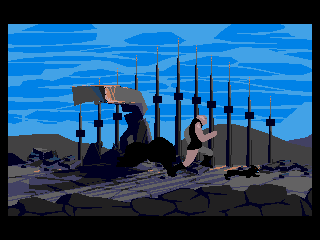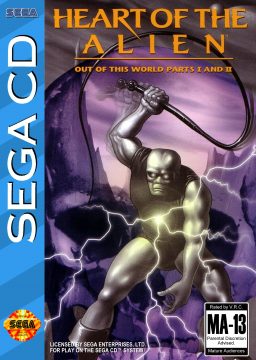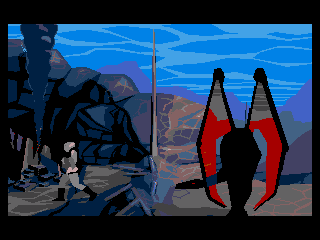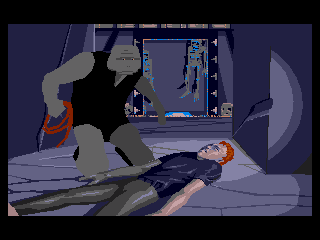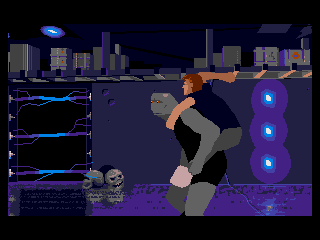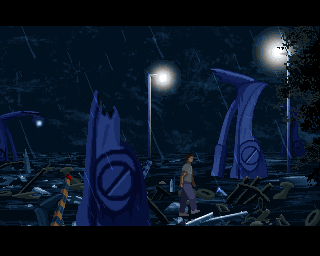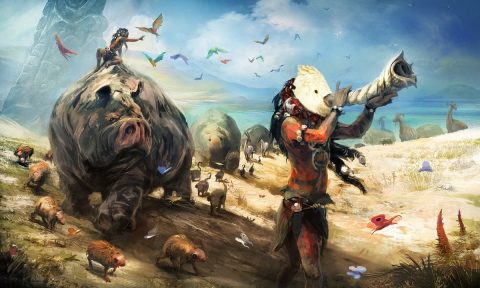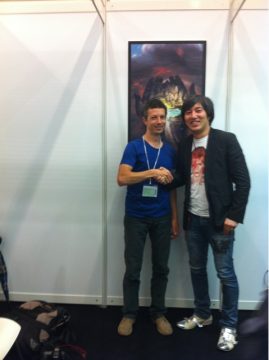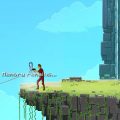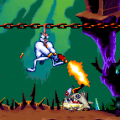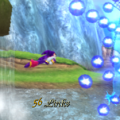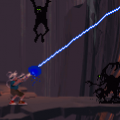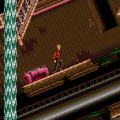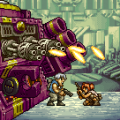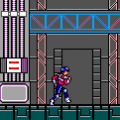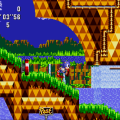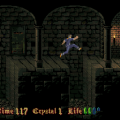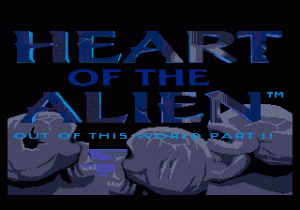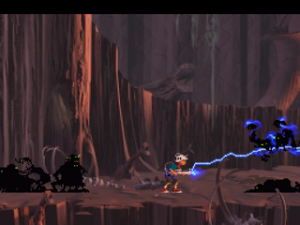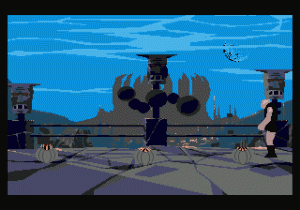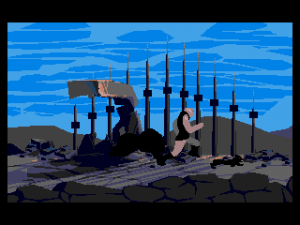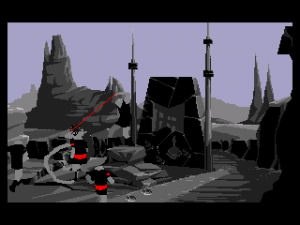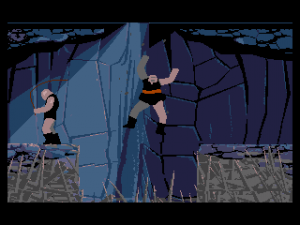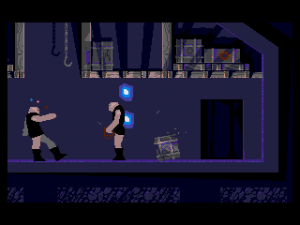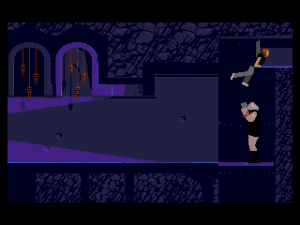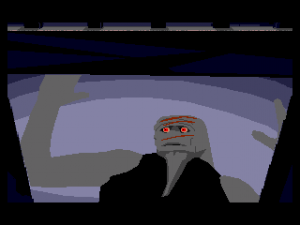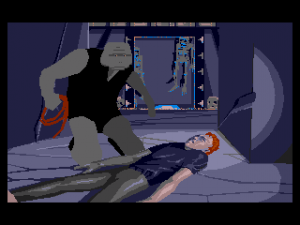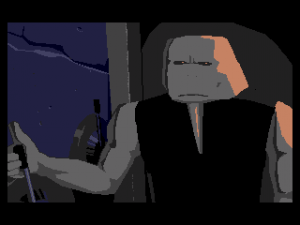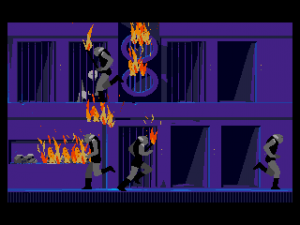- Another World / Out of this World
- Heart of the Alien: Out of This World Parts I and II
Interplay first teased a sequel with their 3DO port of Another World. The extended ending would become the full-fledged into to the sequel which was never planned, Heart of the Alien. Chahi had been adamant about not changing the story or its open ended conclusion, but with Interplay and Delphine constantly pulling him into the idea of further telling Lester’s story, he reluctantly agreed to ink down a few concepts and ideas for another title. Initially the process went well with Chahi finding plenty of inspiration and actually liking the idea of elaborating in the first story. Heart of the Alien was to be, in Chahi’s vision, Another World through the eyes of the alien friend instead of Lester, basically creating a mirror game. You would then get to explore what the alien companion was doing while you were exploring the caves and mansion in the first game, and just like Lester sees his ally running from guards, you would now see Lester fighting and doing what he did as told in the first game from the alien’s perspective. Interplay agreed to the idea, and development began with Chahi onboard.
However, that’s not what came to be the final version of Heart of the Alien. Early in development, Chahi had set his sights and mind on beginning development on his next project. With the formation of his own game studio as well as planning and developing a new game, time simply didn’t permit him to commit much to the sequel that he had so reluctantly agreed on. By the time actual in game development started, he was already deep into work with what would become Heart of Darkness, a game similar to the tone and spirit of Another World. Interplay saw their chance to not only create a chronological follow-up, but to also remove near all of Chahi’s ideas. The ideas that remained were altered to fit their new vision of what the game was to become.
Heart of the Alien picks up right after the end of the first game, with the alien, now nicknamed Buddy, landing himself and Lester in his old village which has been demolished by the dictating forces. Through flashbacks, the viewer now witnesses how everything came to be, and how Buddy ended up in the prison cell along with Lester after a long hard fight in the village. It turns out that Buddy is actually the chief of his village, and that he is fighting an evil ruler identified as “the red eyed alien”. It is this evil mastermind that is behind all the pain and suffering in this world, and when walking through his destroyed home, Buddy decides to hunt this red eyed alien down and settle things once and for all. Lester is still wounded from his fight at the end of the first game, and is left in the hut to rest. Chahi had originally intended for the whole game to be played out during the events of the original from Buddy’s perspective, but this is all done in a flashback cutscene setting up the game instead. While it is interesting to see some of the events that supposedly took place, the direction of these cutscenes leaves a lot to be desired. Once the flashbacks are over with, you get your first objective, to find Buddy’s whip.
Though looking similar and drawing from the framework set by Another World, there’s a lot of new elements to the gameplay in this title. Buddy can jump upwards like in Prince of Persia and grab onto ledges. The biggest addition however is the aforementioned whip. This is the replacement of the laser gun found in the first game. This powerful whip can be swung in any direction, shot laser beams, create force fields and the same strong energy blast as you will be familiar with from the prequel. You can also swing over gaps and dangers by hooking the whip on dripstones and other pointy objects. In this game, dangers truly come from all angles and places so you need to stay on your toes constantly because nearly every screen is filled with danger.
The very first scene of the game is a throwback to the prequel because the first thing that happens is that you stop dead in your tracks due to a black beast appearing and frantically run away, though this time instead of swinging on vines, you make use of your new upwards jump and hide on top of a pedestal. This is sadly the only time this game takes inspiration from its predecessor and does something interesting with it, because it quickly goes downhill from here quite literally. The approach is much somewhat similar, each screen is filled with natural hazards and it’s up to you to navigate yourself through them in one piece. Most dangers were restricted to being projectiles, guards or surface based creatures in the first, but here you now have added airborne dangers, like bats that can fry you by a simple touch. It’s again a fairly short game, taking you through the red eyed alien’s lair for Buddy to infiltrate, destroy their power generator and kill his nemesis. There is in all 13 stages, though some stages are less than a minute long.
If one stripped Another World down naked you’d find some rough spots and awkward controls, but overall a very enjoyable product with varied puzzles and even difficulty. Heart of The Alien is in its entirety an awful game, showered in flaws and led in misdirection. Buddy is so sluggish and slow that time after time, you will find yourself killed because he just simply doesn’t react to your input in time. Again drawing from Prince of Persia, the whole game is based on timing and step based, and room for error is nonexistent. No matter what action you command onto Buddy, there is a full second delay before he will actually as requested. This fault lies in the animation, which tries to be too fluid for its own good. To whip, shot or even run, there is a sequence of animation for Buddy where he prepares the whip or gains speed for his dash which completely breaks the game because it leaves you open to attack, and attacks can come at any time and most often by surprise. At a certain point in the game, you re-unite with Lester for a whopping 20 seconds, enough to tease you into thinking you might actually see duo work together once again.
The first game was groundbreaking for its use of polygons as graphics, and it gave it an iconic and unique look which people still fondly remember. This game tries to emulate that look partially, but uses traditional sprite work instead of polygons for its graphics. On a still screenshot it may look quite stylish and similar, but once you see it in motion it’s an obvious fact that Heart of the Alien does not succeed in retaining the aura and motion of the prequel. The animation is rotoscoped and badly so. The result is too much motion in the characters with arms constantly wailing, goofy walk cycles and frame cuts, making it seem as if everyone is dancing and jiving because they just can’t stop doing the twist. The art directions is also low rent and awfully inconsistent. In one scene, you might see the same style used in Another World, using flat shapes with simple shading like a polygon, while in the very next scene you might encounter a high detailed illustration that looks like a close-up shot in Ren & Stimpy. The only thing that remains consistent is the backgrounds, which are mostly just stone walls and corridors with the blue tinted look.
Perhaps the greatest sin this game commits is the execution of Lester, and the way it handles this event. This was initially an idea suggested by Chahi early in development, but quickly discarded because he felt it gave the game a defined conclusion which was conflicted with his original intention of having the player draw their own conclusions and theories to the story. Nevertheless, when Chahi was gone, Interplay decided to use the idea to climax the story. It is here you find the greatest flaws with the art style and animation because unintentionally, Lester’s death is a hilarious performance of Looney Toons proportions. When Buddy is knocked out by the evil red eyed alien, he decides it’s time to kick some butt and jumps onto the back of the red eyes villain. Lester then proceeds to cover the alien’s eyes and hit him with hammer punches to the top of his head in true Bugs Bunny fashion. Unfortunately for Lester, he is thrown into a force field where he is zapped to death while his skeleton is flashing as he dances the deadly samba till he can dance no more. To illustrate the impact this gruesome event has, the game continues on without making any further mention of Lester until the end cut scene, treating it as an afterthought. You eventually catch up with ol’ red eye, and the final showdown with him is played for laughs to further run the story into the ground.
Heart of the Alien is a disaster from an artistic standpoint, and a mediocre, broken mess of a game. Quickly after it was released, Chahi made a public statement that the title did not represent his vision of the world he crafted and disowned it altogether from being treated as an official sequel. One of the few things that carry over is the music. Composed by none other than Tommy Tallarico, it uses a very atmospheric though more aggressive approach to go along with the added amount of action found in the game. The best feature of this game is the fact that they bundled in Another World for free and allowed Freitas to create a new redbook soundtrack specifically for it. When you finish the first game, it automatically goes into the second game melting them together as one, which would have been a great idea had the sequel been worth playing. Sadly, once the intro for Heart of the Alien rolls around, you are better off shutting off the game and not letting it influence your mind.
Though only officially released on SEGA CD, it would eventually be reverse engineered and portable to other consoles by Gil Megidish under the name Heart of the Alien Redux. Using SDL library language, the game can potentially be ported to homebrew capable system such as Wii, Game Boy Advance, Nintendo DS, Dreamcast and GP32.
Legacy
Another World quickly took the game market by storm and for many changed the perception they had on games, and for some inspired them to start making games themselves.
Not long after Another World saw release, there was another French-made masterpiece on the horizon that would also come through the doors of Delphine. Flashback: A Quest For Identity shared more than a passing similarity to Another World and for a long time, and even still to this day, some people erroneously take it for a sequel. Even though they use similar style graphics and are released by the same company, Chahi had absolutely no involvement with Flashback, and the games are not related to each other beyond the country of origin and publisher. There are some nods to the earlier game found in Flashback however, with the pick-up animation and force field shield being direct tributes to Another World.
In 1997, Hungarian Invictus Games released OnEscapee which was an obvious tribute to Another World and Flashback. It combined the silent storytelling and depressive alien environment as Another World while using the action and puzzle solving of Flashback. The game looks fantastic and features some of the best animation found on the Amiga. When released, it was awarded several Game of the Year 1997 awards from magazines. It has since been released as freeware to play on computers through Invictus’s website.
Being released as Outer World in Japan, it was not as successful there as other places in the Western world, but the impact it has had on the industry is undeniable. Fumito Ueda would draw his main inspirations from Other World for his cult classic Ico, which has since become another candidate in favor of the argument for games as works of art. Hideo Kojima had earlier had success with his games on the MSX like Metal Gear and Snatcher, but has stated that upon playing Outer World, he learned a great amount about storytelling and he goes back to it for inspiration when creating new games. Suda51 of No More Heroes fame openly admits to Outer World being his all-time favorite game and the reason he got interested in game design. In 2010, Suda was able to meet his idol for the first time at Gamescom.
Eric Chahi himself would work 6 years on another adventure game, titled Heart of Darkness. It would be a massive undertaking, being the first video game to employ an orchestra to perform the score and over 3 years to make all the hand drawn animation and FMV sequences found in the game. It was promoted as a cinematic platformer, with some magazines even claiming the animation was “Disney” level quality. While an obvious overstatement, Heart of Darkness looks fantastic and plays in ways similar to Another World. It conveys a motif of loneliness and seeking. It’s also remembered for its gruesome death scenes which contrasts the art style and childlike nature by being shockingly brutal at times. The game was a moderate success, but due to the high cost of development, Amazing Studio went bankrupt after its release and would be the only game from Chahi’s company. The only other planned game was Kaena: The Prophecy, which was turned into a movie instead and released in 2003.
Chahi decided to distance himself from the video game industry due to his frustration with the lack of creativity from other companies and the inability for publishers to take risks on new ideas. He would attend various homebrew conventions in France over years but did not comment on any plans of returning to develop more video games. This changed in 2006 when Chahi stated in an interview that he had finally started playing around with a few ideas, and was interested in trying to make either a puzzle or simulation game inspired from his travels and artwork projects over the years. At E3 2010 this idea finally became reality with the announcement of From Dust, a sandbox simulation where the player takes the role of God and controls the daily lives of the inhabitants of an island. It will be published by Ubisoft in 2011 and released on all download services.
Another World is one of the most interesting pieces of video game history because of the clear examples and standards it sets. On one hand, it is a shining display of interactive art, telling a story of unspoken friendship and trust in an ambiguous world which blossoms from the imagination of the player. With its timeless art style and easy controls, it still manages to find new fans to this day. On the other hand, it’s a showcase of how a property can be completely misunderstood and ruined in the hands of the wrong people. Interplay was relentless in their demand to flesh out the game and create a fully told world and story, robbing the player of their curious freedom and self-narration which made the game so special in the first place. By each version, the changes took more and more away from the soul of the game and in the end, their “conclusion” to the story is a badly written and poorly executed. Regardless, the original game has stood the test of time, and Chahi’s work of art is one that will always be remembered as one of the finest video games ever made.
